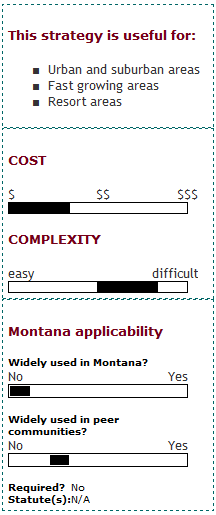

What are frontage road requirements?
Frontage roads are small service roads designed for lower volume local traffic and run parallel to main roads, either around developments or adjacent to freeway facilities. The purpose of frontage roads is to provide local access and separate local and through traffic in the interest of minimizing conflict points. Backage roads, or reverse frontage roads run parallel to a higher volume road and are behind the adjacent buildings, instead of between the buildings and the major road. Frontage roads are usually considered one solution for access management. Frontage road ordinances may specify the circumstances where local governments may require construction of, reservation of easement for, or funding for a frontage road.
Who can implement it?
State DOTs can implement a frontage road policy. This policy could address the need for frontage roads along major roads where the traffic volume has increased to where providing direct driveways is no longer safe. Providing some language that indicates frontage roads are the preferred solution in these instances is an option. Local jurisdictions can also implement frontage road policies as well.
Some localities prefer backage roads for areas where the major road has become too busy for direct access. Some research has indicated that backage roads provide more access to a greater number of businesses and can increase the value of adjacent land while reducing road construction costs for individual properties. Backage roads are also beneficial for freight delivery.
Proactively, local governments can require that property owners reserve sections of right-of-way for future frontage (or backage) road construction if ever necessary, as in Brooksville, FL.
What are the keys to success and potential pitfalls?
Developers may be very resistant to the requirement to provide needed frontage roads, and will most likely contest. Explicitly worded requirements without loopholes will ensure success. Politicians and other decision-makers may suggest providing other options for developers if they do not want to provide the right-of-way, but this would make achieving the frontage road system nearly impossible.
Frontage roads that are close to the corresponding parallel major road can make for confusing intersections, especially when the frontage road intersects with a major side-street. Advance planning for frontage roads and an innovative design team are important for finding a solution that is easily comprehensible for drivers. Providing adequate separation at intersections between the frontage road and the main road is also key.
Frontage roads should not become another avenue for through traffic. It is important to deemphasize through traffic on local roads with low speed limits, narrow lanes and other traffic calming measures. Pedestrians walking along a frontage road should feel safe.
Right-of-way acquisition is often the most expensive part of any construction cost. If at all possible, it is advantageous best to acquire ROW in a piecemeal fashion.
A well thought-out plan can help give direction to an area where a frontage road is needed. Acquiring right-of-way in a piecemeal fashion will create gaps, but a strong plan can keep the momentum going.
Where has this strategy been applied?
Examples in Montana
Frontage roads exist in various areas throughout Montana, but most if not all Montana communities have not adopted specific ordinances to require frontage roads. The following are examples where the development of local access roads has been incorporated into projects as a means of addressing specific access needs:
- MDT's Four Corners-North project on Montana Highway 85 (Jackrabbit Lane) between Four Corners and Belgrade in Gallatin County included an Access Management Plan that called for the private developers to provide internal roadways in subdivisions adjacent to the highway. Direct connections to the highway will only be allowed at spacings (typically one-half mile or 1 mile) as outlined in the Access Management Plan for the project. Similar access roads have been developed along sections of US Highway 93 south of Missoula in the Victor-Florence area. Frontage roads have also been discussed as an access management concept for the reconstruction of US Highway 93 between Evaro and Polson.
- Subdivision Regulations in Montana typically include a provision that says the governing body may require frontage roads or other treatment as necessary to adequately protect residential properties and to separate arterial and local traffic whenever a subdivision abuts or contains an existing or proposed arterial highway or major thoroughfare.
Examples outside of Montana
- Hernando County, FL adopted a frontage road ordinance that requires each developer of property adjacent to major arterial highways to provide for the funding and construction of frontage roads upon demonstration of need and demand by the county. This system has worked remarkably well along U.S. 19 and Route 50, reducing congestion and accidents.
- The City of Brooksville, FL adopted an ordinance allowing the city to impose the requirement to reserve an easement for the frontage road and require the necessary financial assurances, but to later waive the requirement should it prove unnecessary.
How can I get started?
Assessing an area's context is an important first step for any policy or plan. Frontage roads may only be appropriate solutions for a select few major roads in an area. Designating where frontage roads may be needed is critical. Envisioning the future context of the area served by the frontage road will help in making decisions about what kind of frontage road policy to implement. Developing a plan for these roads is crucial, as the frontage roads must be able to serve the future area and remain consistent with the land use and other transportation improvements in the community.
Where can I get more information?
- Kara Kockelman et al. (2003). Frontage Roads: Assessment of Legal Issues, Design Decisions, Costs, Operations, and Land-Development. Journal of Transportation Engineering. Volume 129, Issue 3, pp. 242-252.
- Investigation of the Impact of Frontage Roads as an Element of Controlled Access Facilities: Project Summary Report
- Texas Frontage Road Policy.
- Master Plan of Allen County, Indiana. See section 2-3-3-5
- San Juan County Road Policy - Access Management Policies and Standards.
